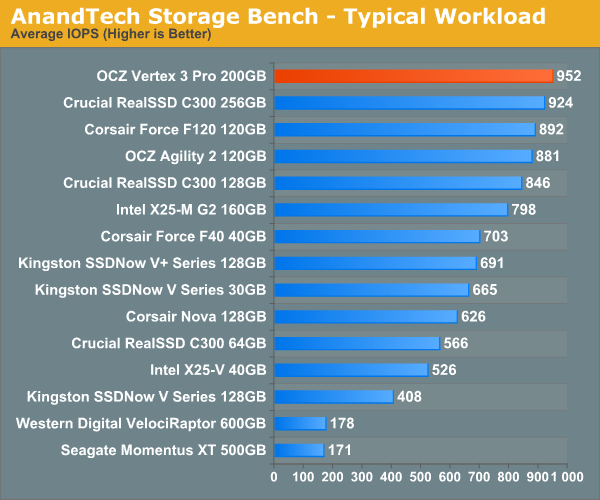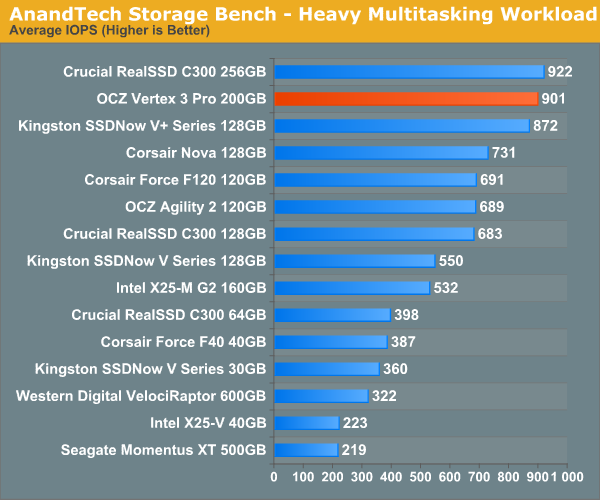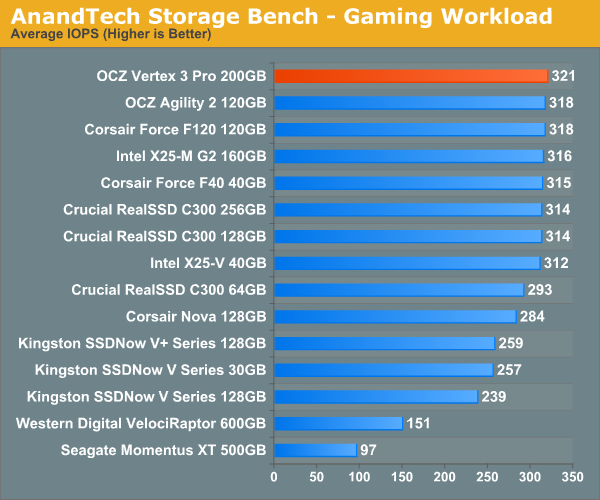OCZ Vertex 3 Pro Preview: The First SF-2500 SSD
by Anand Lal Shimpi on February 17, 2011 3:01 AM ESTAnandTech Storage Bench 2010
To keep things consistent we've also included our older Storage Bench. Note that the old storage test system doesn't have a SATA 6Gbps controller, so we only have one result for the Vertex 3 Pro (and the C300). The SF-2500 controller does respectably here, but with a 3Gbps controller we're only marginally faster than other SSDs (which is why we've moved to a new storage platform for 2011).
The first in our benchmark suite is a light/typical usage case. The Windows 7 system is loaded with Firefox, Office 2007 and Adobe Reader among other applications. With Firefox we browse web pages like Facebook, AnandTech, Digg and other sites. Outlook is also running and we use it to check emails, create and send a message with a PDF attachment. Adobe Reader is used to view some PDFs. Excel 2007 is used to create a spreadsheet, graphs and save the document. The same goes for Word 2007. We open and step through a presentation in PowerPoint 2007 received as an email attachment before saving it to the desktop. Finally we watch a bit of a Firefly episode in Windows Media Player 11.
There’s some level of multitasking going on here but it’s not unreasonable by any means. Generally the application tasks proceed linearly, with the exception of things like web browsing which may happen in between one of the other tasks.
The recording is played back on all of our drives here today. Remember that we’re isolating disk performance, all we’re doing is playing back every single disk access that happened in that ~5 minute period of usage. The light workload is composed of 37,501 reads and 20,268 writes. Over 30% of the IOs are 4KB, 11% are 16KB, 22% are 32KB and approximately 13% are 64KB in size. Less than 30% of the operations are absolutely sequential in nature. Average queue depth is 6.09 IOs.
The performance results are reported in average I/O Operations per Second (IOPS):

If there’s a light usage case there’s bound to be a heavy one. In this test we have Microsoft Security Essentials running in the background with real time virus scanning enabled. We also perform a quick scan in the middle of the test. Firefox, Outlook, Excel, Word and Powerpoint are all used the same as they were in the light test. We add Photoshop CS4 to the mix, opening a bunch of 12MP images, editing them, then saving them as highly compressed JPGs for web publishing. Windows 7’s picture viewer is used to view a bunch of pictures on the hard drive. We use 7-zip to create and extract .7z archives. Downloading is also prominently featured in our heavy test; we download large files from the Internet during portions of the benchmark, as well as use uTorrent to grab a couple of torrents. Some of the applications in use are installed during the benchmark, Windows updates are also installed. Towards the end of the test we launch World of Warcraft, play for a few minutes, then delete the folder. This test also takes into account all of the disk accesses that happen while the OS is booting.
The benchmark is 22 minutes long and it consists of 128,895 read operations and 72,411 write operations. Roughly 44% of all IOs were sequential. Approximately 30% of all accesses were 4KB in size, 12% were 16KB in size, 14% were 32KB and 20% were 64KB. Average queue depth was 3.59.

The gaming workload is made up of 75,206 read operations and only 4,592 write operations. Only 20% of the accesses are 4KB in size, nearly 40% are 64KB and 20% are 32KB. A whopping 69% of the IOs are sequential, meaning this is predominantly a sequential read benchmark. The average queue depth is 7.76 IOs.











144 Comments
View All Comments
cgorange - Thursday, February 17, 2011 - link
Anand,Is there some reason that the Samsung 470-series wasn't included on all charts?
Diosjenin - Thursday, February 17, 2011 - link
"Paired with a decent SSD controller, write lifespan is a non-issue. Note that I only fold Intel, Crucial/Micron/Marvell and SandForce into this category."So did you deliberately or accidentally leave out Indilinx?
Chloiber - Thursday, February 17, 2011 - link
Of course he couldn't include all the controllers, only those which he tested thorougly. So I'm pretty sure he left them out deliberately because there are so many broken drives from Indilinx. My 32GB drive also went down the drain. Maybe it was also part of the many, MANY broken firmwares they released. But even if you trust their SMART values, the write amplification on those drives is VERY high.Mr Perfect - Thursday, February 17, 2011 - link
I'm glad to see a component review on AT again, even if it's just a preview. It has been feeling like Engaget or some other phone review site around here.cactusdog - Thursday, February 17, 2011 - link
haha i know, they seem to like phones these days.MrBrownSound - Thursday, February 17, 2011 - link
nice to see that the intel x-25m still is in the ranks of the new generation drives.I bought a intel x25-m 160GB and booted my OS right away without reformating. Will it suffer performance loss?
ajp_anton - Thursday, February 17, 2011 - link
Your "x GB drive appears as y GB in Windows" look very much like GB<->GiB conversion errors.deadrock01 - Thursday, February 17, 2011 - link
Anand,Any possibility of getting the OCZ Revo PCI Express Cards and other SSD-like items in the SSD benchmark list?
marraco - Thursday, February 17, 2011 - link
^^^that.ilkhan - Thursday, February 17, 2011 - link
Numbers look real nice.For someone on a budget looking for a 120GB (or close enough) SSD on a 3Gbps controller, whats the recommendation. Wait for the new drives, grab a corsair force, else?